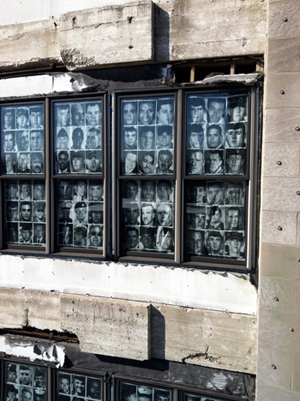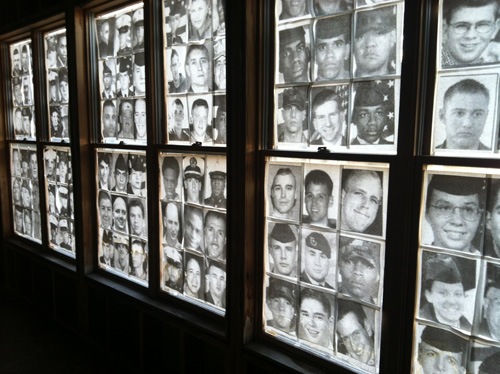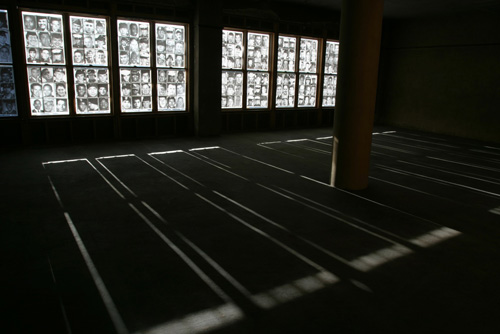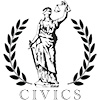| « Gas and Cigarettes and Addiction Funding | Mayor and Police Chief Roll Out Gang-Reduction Strategy » |
Veterans Sun May 27 2012
The Faces in the Windows: Creators Debate the Future of the Façade Project
By Myles Dannhausen
There are just faces. No sign. No numbers. No flag.
 In the windows above the Chicago Printmakers' Collaborative a powerful memorial to the United States servicemen killed in the War in Iraq is fading. Six hundred forty-eight faces fill three stories of windows. Some are now torn, faded, water-stained, or simply falling down.
In the windows above the Chicago Printmakers' Collaborative a powerful memorial to the United States servicemen killed in the War in Iraq is fading. Six hundred forty-eight faces fill three stories of windows. Some are now torn, faded, water-stained, or simply falling down.
"We have to keep repairing it," says the Collaborative's owner, Deborah Lader. "We go up and tape pieces back up."
Each piece is the face of a soldier who lost their life serving in Iraq. The Façade Project, created in August of 2004 by artist Carrie Iverson, abuts the tracks of the Brown Line's Western stop in Lincoln Square at 4642 Western Ave. There, the faces of the fallen peer out at the thousands of riders who pass through the stop every day.
By the time the project was completed in August of 2004 it was clear the war would not be the tidy six-month engagement that former Defense Secretary Donald Rumsfeld infamously predicted. The deaths of soldiers were no longer getting front-page hero treatment. As the death toll climbed, the faces slipped deeper and deeper into the paper and out of newscasts.

The faces of the Façade Project are deteriorating, leading its creators to question whether it remains an appropriate memorial to the fallen. Photo by Myles Dannhausen.
With the 2004 Presidential election around the corner, Lader wanted to do something to bring attention to the war, but not in an overtly political way. Iverson came up with the idea for the Façade Project.
"The initial idea was that it would stay up till the war ended," Iverson says. But even Iverson and Lader, in spite of their opposition to the war and doubts about an early exit, didn't expect to be looking at it eight years later.
The last combat troops came home from Iraq Dec. 18, 2011, but now Iverson and Lader are struggling with whether to take the faces down as originally planned.
Lader says the deterioration of the faces actually adds to the power of the project's message.
"We knew when we put them up that these things were going to fade, they were going to have water stains, people were going to stop noticing it as they ride the train," she says. "It's the same way memory works. Are we going to remember that all these people died? Are we going to remember the sacrifice all these people made in our next march to war? People don't remember, unless your dad is up there or your brother."
But she also understands that the same things that she sees as powerful, others might see as insulting.
"There are some people who think it should come down now," she says. "They think it's disrespectful to keep up something that's falling apart."
Aaron Hughes is an Army National Guard veteran who served in Iraq and Kuwait from 2003 — 2004. He gained notoriety during the NATO protests for leading a group of veterans who returned their war medals. He says he sees the debate about whether to take the Façade Project down is a strange one.
"When should we stop remembering?" he asks. "If anything, now is a more crucial time for this memorial because people may think that the struggle does end with the soldiers coming home. At least this is a reminder that these lives have been lost. Now, it's particularly profound."

The most dramatic views of the Façade Project are seen from the inside, where creator Carrie Iverson says you see the faces "the way they would see themselves in the mirror." Photo by Lia Conklin.
Hughes is a field organizer for Iraq Veterans Against the War and the Art Committee of the National Veterans Art Museum. He laments that the days set aside to honor veterans, Memorial Day in particular, have become days to celebrate consumer culture with sales. In that culture, he says that even if most of us pass the faces staring blankly over Western Avenue without a second thought about the lives lost, the project remains a valuable remembrance.
"Maybe it's not on the top of your mind, but if they see it, people are thinking about on some level," Hughes says. "I appreciate it being there. There is this real loss and we have to remember that."
The most powerful perspective of the portraits is one most people never see. From inside the empty, abandoned upper floors of the building, the project takes on a ghostly effect. The sunlight shines through the soldiers' faces like the stained glass windows of a cathedral and you find yourself, in Iverson's words, "seeing them the way they would see themselves in the mirror."
On a small table there are candles, photos, and notes left behind. They serve as simple shrines to the fallen.

Deborah Lader, owner of the Chicago Printmakers' Collaborative. Photo by Myles Dannhausen.
Lader says an Iraqi family visited and asked to see it from the inside. They told her they had been unable to locate family members displaced by the war.
"They were in tears, and I felt bad because all the faces were of American soldiers," Lader says. "But they kept saying to me that this is about humanity, not one side or the other. They were just moved by all the faces and they were as moved as anyone here who was American."
Lader welcomes input about what should be done with the memorial. For now, she's keeping the faces in the windows, and hopes they serve to provide some small dose of realism during the next march to war.
"The fact that over 4,000 people need a place to put their faces now is really scary to me," Lader says. "That memory shouldn't go away. Their families are going to be grieving for the rest of their lives. We shouldn't forget that. If we remember, maybe we won't do it again."
Exterior photo by Lia Conklin.












spudart / May 29, 2012 2:34 PM
As someone who uses the Western brown line station every day, I really enjoy this article about this installation.
Thinking this through, I'd like to print out a couple of the portraits and put them in my apartment window in Lincoln Square. I don't know how long I'd keep mine up, but I would at least like to make the effort for a brief period of time to expand this project further into the community. Perhaps others would participate as well.